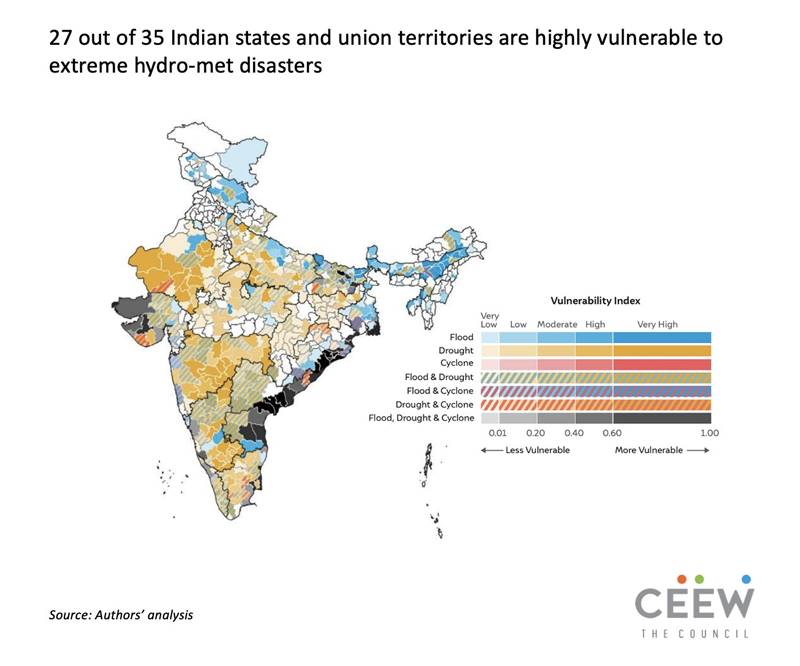80% Indians live in climate-vulnerable districts: Study
A study shows Assam, Andhra Pradesh, Maharashtra, Karnataka and Bihar are most vulnerable to extreme climate events such as floods, droughts and cyclones. The study stressed that with losses rising exponentially due to the climate crisis, India must demand climate finance for adaptation-based climate actions.


The northern and north-eastern zones are more vulnerable to extreme flood events. Photo: CEEW study
More than 80 per cent of Indians live in districts vulnerable to climate risks, a recent study has found. Dhemaji and Nagaon in Assam, Khammam in Telangana, Gajapati in Odisha, Vizianagaram in Andhra Pradesh, Sangli in Maharashtra, and Chennai in Tamil Nadu are among India’s most climate vulnerable districts.
Of the total 35 states and Union territories in the country, 27 are vulnerable to climate risks, the study highlighted. Assam, Andhra Pradesh, Maharashtra, Karnataka and Bihar are most vulnerable to extreme climate events such as floods, droughts and cyclones in India. This was pointed out in a study conducted by Council on Energy, Environment and Water (CEEW), a New Delhi-based not-for-profit organisation.

The study titled ‘Mapping India’s Climate Vulnerability: A District-Level Assessment’ released today on October 26 highlighted that the northern and north-eastern zones are more vulnerable to extreme flood events and their compounding impacts, while the ones in the south and central are most vulnerable to extreme droughts. Also, 59 per cent and 41 per cent of the total districts in the eastern and western states, respectively, are highly vulnerable to extreme cyclones.
The study also highlighted that 463 out of 640 districts in India are vulnerable to extreme floods, droughts and cyclones. More than 45 per cent of these districts have undergone unsustainable landscape and infrastructure changes.

“The frequency and intensity of extreme climate events in India have increased by almost 200 per cent since 2005. Our policymakers, industry leaders and citizens must use the district-level analysis to make effective risk-informed decisions. Climate-proofing of physical and ecosystem infrastructures should also now become a national imperative,” Abinash Mohanty, Programme Lead, CEEW, and lead author of the study, was quoted as saying in the press statement issued by CEEW.
The CEEW study also revealed that 63 per cent of districts in India have a District Disaster Management Plan (DDMP). While these plans need to be updated every year, only 32 per cent of them had updated plans until 2019, showed the study. Highly vulnerable states such as Maharashtra, Tamil Nadu, Odisha, Karnataka and Gujarat have improved their respective DDMPs and climate-proofed critical infrastructures in recent years.
The study has been released a week ahead of the 2021 United Nations Climate Change Conference, also known as COP26 scheduled to be held in Glasgow, Scotland, United Kingdom, between October 31 and November 12 this year.
“With loss and damage rising exponentially due to the climate crisis, India must demand climate finance for adaptation-based climate actions at COP-26. Enhanced climate finance can also support India-led global agencies like the Coalition for Disaster Resilient Infrastructure (CDRI) to further mainstream climate actions,” said Mohanty.
The study was supported by the India Climate Collaborative, a collaborative platform working to combat climate change, and Edelgive Foundation, a grant-making organisation.

